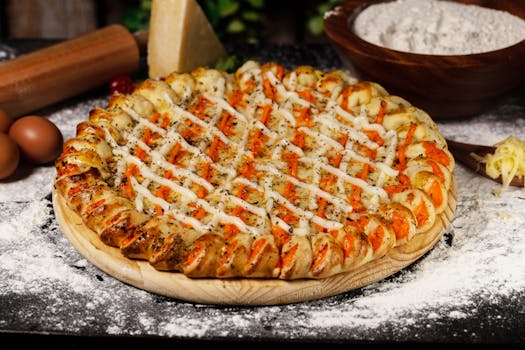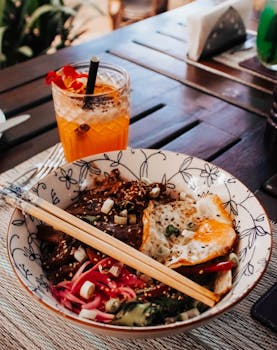Anúncios
The way we consume and interact with food has dramatically changed over the past decade. Social media platforms have transformed not only how we share culinary experiences but also how we discover new foods. As images and videos of mouth-watering dishes flood our feeds, our attitudes and behaviors towards food continue to evolve.
This article will explore the multifaceted impact of social media on food, addressing various aspects such as trends, marketing, and cultural influences. By delving into these areas, we can better understand the significant role social media plays in shaping our food choices and experiences.
As we navigate through this discussion, it will become evident that social media is both a powerful tool and a double-edged sword in the culinary landscape. From inspiring home cooks to influencing dietary habits, the effects are profound and far-reaching.
The Rise of Food Photography
Food photography has taken social media by storm, turning meals into visual stories. Platforms like Instagram and Pinterest thrive on vibrant, well-composed food images. This trend encourages even amateur cooks to present their creations beautifully.
The aesthetic appeal of food images plays a crucial role in attracting attention. Peoples’ feeds are filled with enticing dishes, often leading to cravings and an urge to try similar recipes. Good food photos can prompt users to explore new cuisines.
Anúncios
Moreover, the hashtags associated with food photography amplify the reach of these images. Creative tags can garner thousands of views, connecting food lovers across the globe. This has created a new niche within social media dedicated solely to food aesthetics.
Restaurants and chefs have also recognized the importance of food photography. They invest in professional photography to showcase their dishes, knowing that a single image can capture the essence of their culinary brand. Offers and promotions are often paired with visually appealing images.
As a result, food photography has evolved from a simple pastime into a legitimate marketing strategy. Establishments that embrace this trend often see increased foot traffic and online engagement, demonstrating its effectiveness in the competitive food industry.
Anúncios
Influence on Food Trends
Social media significantly influences food trends, often leading to the rapid rise and fall of various diets and culinary fads. Platforms like TikTok have become breeding grounds for viral food challenges and recipes. These trends can spread quickly, reaching a vast audience in days.
For example, the whipped coffee trend (Dalgona coffee) captivated users and resulted in a flurry of posts showcasing this simple yet visually appealing drink. Such trends not only promote new recipes but also enhance interaction among followers.
Moreover, social media allows for the democratisation of culinary trends. Anyone can share their creations, leading to grassroots movements within food culture. Home cooks and food enthusiasts can gain recognition for innovating or tweaking traditional recipes.
Collaborations between influencers and food brands play a crucial role in promoting these trends. As influencers showcase trendy recipes, they motivate their followers to recreate these dishes. This creates a cycle of engagement, further amplifying the trend.
However, the fast pace at which trends emerge can sometimes lead to culinary oversaturation. Users may feel pressured to keep up with the latest food fads, which can detract from the joy of cooking and enjoying food.
Social Media and Food Education
In addition to influencing trends, social media serves as an educational platform for food enthusiasts. Countless chefs, nutritionists, and culinary professionals share valuable tips, tricks, and recipes through videos and blogs. This access fosters a community of learners eager to improve their cooking skills.
Platforms like YouTube offer cooking demonstrations, allowing viewers to learn visually. Tutorials range from beginner to advanced techniques, making culinary skills accessible to everyone. This democratization helps break down barriers for aspiring home chefs.
Moreover, social media allows users to engage in discussions around food topics. Users can ask questions, share experiences, and offer advice, creating an inclusive environment. This interaction encourages a deeper understanding of cooking processes and food culture.
Nutrition education has also benefited from social media. Influencers and experts share dietary information, healthy recipes, and cooking tips, promoting better eating habits among followers. This shift toward health-conscious cooking reflects a growing interest in personal wellness.
However, it’s important to approach information shared on social media with caution. Not all content adheres to strict nutritional science, so users must critically evaluate sources to ensure they’re receiving credible information.
The Role of Influencers and Marketing
Food influencers have become key players in the social media landscape, shaping opinions and preferences. Their curated content resonates with followers, positioning them as trusted sources of inspiration and information. Brands leverage their influence to market products effectively.
Collaborations between food brands and influencers often result in sponsored content that showcases products in authentic settings. This strategy engages consumers more effectively than traditional advertising methods. Followers are more likely to trust recommendations from someone they admire.
As a result, influencers help drive consumer behavior, informing purchasing decisions. Their endorsements can launch a product into popularity, significantly impacting sales and brand loyalty. This dynamic has transformed the food marketing landscape.
Moreover, influencers narrate their culinary journeys, making them relatable to their audience. Their storytelling shapes the way followers perceive food, instilling a sense of community within the cooking experience. This connection is vital in building brand loyalty.
However, the influencer-driven landscape requires ethical considerations. Transparency in sponsorships is crucial as consumers grow increasingly aware of persuasive marketing tactics. Influencers must maintain authenticity to keep their followers’ trust while navigating this complex environment.
Cultural Representation in Food Sharing
Social media has facilitated the sharing of diverse culinary traditions, allowing users to explore global cuisines. Food represents culture, heritage, and identity, and social media platforms create space for underrepresented voices to showcase their dishes and stories.
Through the sharing of recipes, cooking tips, and cultural anecdotes, users gain access to diverse culinary experiences. This exposure encourages cross-cultural understanding, fostering appreciation for global cuisines. A beautifully presented dish can tell a rich story of tradition.
However, cultural representation on social media must be approached with sensitivity. Appropriation versus appreciation is a fine line that creators must navigate. Authenticity in sharing cultural dishes honors their origins while preventing misunderstanding or misrepresentation.
Additionally, social media allows communities to reclaim and celebrate their food traditions, reinforcing cultural pride. Users can share personal narratives tied to dishes, enriching the narrative surrounding their culinary heritage.
Ultimately, social media’s impact on cultural representation in food cultivates dialogue and curiosity. These platforms can promote inclusivity, ensuring that all voices are heard within the culinary conversation.
The Impact on Eating Habits
As social media continues to influence food culture, it has also reshaped eating habits. The abundance of appealing food content can lead to increased consumption, as users may feel tempted to try trending dishes. This constant exposure can influence personal dietary choices.
Conversely, individuals may adopt healthier eating habits by following wellness influencers. With posts celebrating nutritious meals, many users feel encouraged to prioritize health-conscious choices. This shift can result in a broader focus on balanced lifestyles.
Furthermore, social media offers platforms for diet trends and movements, educating users about various eating styles. From veganism to gluten-free living, the information shared fosters engagement and discussion surrounding dietary choices.
However, the pressure to conform to online expectations can lead to unhealthy behaviors. Users may find themselves comparing their meals to those seen online, potentially leading to issues such as disordered eating. Awareness of this impact is essential.
Striking a balance between inspiration from social media and personal dietary needs is crucial. By curating a positive online environment and focusing on moderation, users can enjoy the benefits of social media without detriment to their well-being.
Conclusion
The impact of social media on food is profound and multi-dimensional. From reshaping culinary trends and fostering education to highlighting cultural representation, these platforms significantly influence our dining experiences. It is crucial to navigate this space mindfully.
As we engage with food-related content online, striking a balance between inspiration and authenticity is essential. By approaching social media thoughtfully, we can appreciate the rich diversity of culinary traditions while making informed choices that align with our values.
Ultimately, social media can enhance our connection to food, creating a vibrant online community that continually inspires and educates. Embracing this platform responsibly can yield positive outcomes for both individual and collective food experiences.
| Aspect | Impact | Examples |
|---|---|---|
| Food Photography | Aesthetic influence on food consumption | Instagram posts showcasing unique dishes |
| Food Trends | Rapid emergence of new culinary fads | TikTok challenges and viral recipes |
| Education | Increased accessibility to culinary knowledge | YouTube cooking tutorials and tips |
| Influencers | Reshaping consumer behavior and preferences | Sponsored posts highlighting food products |
| Cultural Representation | Promotion of global cuisines and traditions | Sharing traditional recipes with personal stories |
- The aesthetic appeal of food is essential in attracting attention.
- Food trends can spread rapidly through social media channels.
- Educational content fosters improved cooking skills for followers.
- Influencers play a key role in shaping opinions about food.
- Cultural representation promotes inclusivity in culinary conversations.



